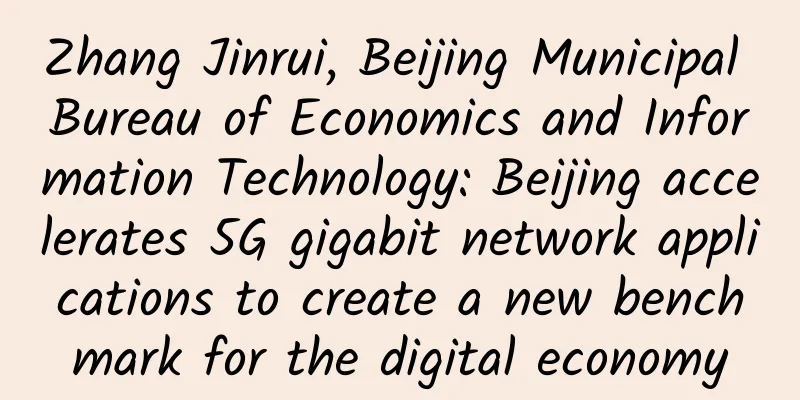Zhang Jinrui, Beijing Municipal Bureau of Economics and Information Technology: Beijing accelerates 5G gigabit network applications to create a new benchmark for the digital economy

|
At the "Third 5G Gigabit Network Industry Forum" held today, Zhang Jinrui, deputy director of the Electronics Department of the Beijing Municipal Bureau of Economy and Information Technology, said that Beijing continues to attach importance to the development of 5G Gigabit Network. At present, there are 44,000 5G base stations and 1.516 million 5G users, which consolidates the network foundation and builds a solid foundation for digital transformation and application innovation. Beijing has also created eight scene applications such as 5G+ information consumption, 5G+ converged media, and 5G+ industrial Internet to lead the development of 5G. In addition, Zhang Jinrui revealed that Beijing will start from "six aspects" to promote the implementation of 5G large-scale applications in the next step. With the Internet as the foundation, Beijing continues to attach importance to the development of 5G gigabit networkZhang Jinrui pointed out that 5G, as a new generation of mobile communication technology, is integrating and innovating with information technologies including cloud computing, big data, edge computing, artificial intelligence, AR/VR, and visual sensing, together forming the infrastructure of the future digital society and laying the foundation for the digital transformation of thousands of industries. In order to support the construction and development of 5G gigabit networks, Beijing has released a number of action plans. The Beijing 14th Five-Year Plan for the Development of the Information and Communication Industry points out that we should vigorously build infrastructure such as 5G networks, gigabit fixed networks, industrial Internet, and big data platforms to promote the popularization of new 5G applications such as autonomous driving, telemedicine, and high-definition live broadcasting. It is expected that by the end of 2025, 63,000 5G base stations will be built and put into operation in the city, basically achieving continuous coverage of cities, towns, administrative villages, and main roads. The Beijing Implementation Plan on Accelerating the Construction of a Global Digital Economy Benchmark City also clearly proposes to build an internationally leading network infrastructure. Accelerate the "Dual Gigabit" plan to achieve gigabit access to homes and full coverage of 5G networks. Plan and build a dedicated network and edge computing system that supports digital native, and build a new generation of digital cluster private network, high-reliability and low-latency Internet of Vehicles, industrial Internet, satellite Internet, etc. As a key driving force for the digitalization, networking, and intelligent transformation and upgrading of the economy and society, 5G is an important engine for promoting the high-quality development of the digital economy and providing strong support for improving the level of social governance. "Therefore, we should build a solid foundation for digital transformation and application innovation based on the network," Zhang Jinrui emphasized. Since Beijing took the lead in launching the construction of 5G test networks in 2017, it has been a benchmark region for the construction of 5G networks and the promotion of various applications in China. With strong policy support and the joint efforts of the industrial chain, Beijing's 5G infrastructure construction leads the country. According to Zhang Jinrui, Beijing's 5G network has basically achieved continuous outdoor coverage within the Fifth Ring Road and the city's sub-center, as well as precise coverage of key areas and typical application scenarios outside the Fifth Ring Road. The number of 5G base stations has reached 44,000, an increase of 6,435 from the end of last year. At the same time, Beijing is making every effort to promote 5G network coverage in important places such as hospitals, campuses, cultural and tourist areas, transportation hubs, along key roads, subway platforms and tunnels, and passenger railway stations. Currently, the number of 5G users has reached 1.516 million, a net increase of 5.132 million from the end of last year. Applications as the pulse, "eight scenarios" lead the development of 5GZhang Jinrui pointed out that application is the core of 5G. Beijing focuses on building eight scenarios including 5G+information consumption, 5G+integrated media, 5G+industrial Internet, 5G+autonomous driving, 5G+smart logistics, 5G+smart medical care, 5G+smart education, and 5G+cultural tourism to lead the development of 5G. In terms of 5G+ information consumption, Beijing has cooperated with the three major operators, JD.com, Meituan, Xiaomi and other companies to promote the rapid development of new information consumption through two means. "Zhang Jinrui said that on the one hand, by carrying out a series of "Information Consumption Festival" activities, combined with the current 5G consumption hotspots, targeting new 5G users, through subsidies for traffic and terminals, it effectively leverages citizens' information consumption; on the other hand, it continues to promote Meituan, JD.com, Suning, Xiaomi, Tencent, Duodian and other companies to actively participate in the deep integration of 5G and smart home, and develop new wearable devices and service robots based on 5G technology. In terms of 5G+ integrated media, Beijing has taken advantage of its strengths and led the way in 5G ultra-high-definition video applications. It has carried out 5G business applications in conjunction with major events, and actively carried out 5G ultra-high-definition live broadcasts in the fields of sports events, cultural communication, e-sports games, and conferences. It has supported the application of new equipment to accelerate the intelligent upgrade of media processes, and with the advantages of 8K, it has taken the lead in the application of new equipment such as 5G backpacks and 8K broadcast vehicles; it has completed the industrial layout to promote 5G radio and television applications, and carried out joint technical trials, and research and planning on broadcast business applications. In terms of 5G+Industrial Internet, Beijing has set a benchmark and achieved remarkable results in the innovation of Industrial Internet. At present, the more successful cases include the Intelligent Security Industry Base of China Construction Third Engineering Bureau, the Smart Factory of Sany Heavy Industry in Changping, and the Xiaomi "Dark Factory" in Yizhuang. In addition, JD.com, Beijing Benz, BOE, Schneider and other companies have upgraded their smart factories. In terms of 5G+autonomous driving, Beijing is accelerating its layout, and the intelligent transportation industry is developing steadily. Beijing is building a security situation awareness platform, with 762.52 kilometers of open test roads, and 30,000 unmanned delivery vehicles will be on the road one after another. Beijing has planned and built the National Intelligent Automobile and Intelligent Transportation (Beijing-Hebei) Demonstration Zone, Zhongguancun Environmental Protection Park, and the 100-square-kilometer autonomous driving demonstration zone in the northern area of Zhongguancun Science City. Data shows that intelligent transportation has covered 85% of traffic scenarios in cities, villages, highways, etc. in the Beijing-Tianjin-Hebei region. As of August 2021, Beijing's road test safe driving mileage of autonomous driving vehicles exceeded 3,604,256 kilometers. In terms of 5G+ smart logistics, JD Logistics' "Asia No. 1" smart logistics base in Beijing is the country's first highly intelligent, autonomous, integrated 5G smart logistics demonstration park, using 5G technology to achieve real-time scheduling, optimal vehicle configuration, and transport capacity matching. In terms of 5G+ smart healthcare, Beijing has actively explored and promoted the application of 5G in the medical field. In terms of 5G+ epidemic prevention and control, the digital supervision of the collection, transmission and management chain of the unified platform for nucleic acid testing information has been completed; in terms of 5G+ remote consultation, Ditan Hospital, Xiaotangshan Hospital and Wuhan "5G Remote CT Collaboration Platform"; in terms of 5G+ remote surgery, classic cases such as the "MR+5G" venous filter implantation surgery of the General Hospital of the People's Liberation Army continue to emerge; in terms of 5G+ pre-hospital emergency care, the Beijing Emergency Center's 5G smart ambulance has opened up the entire process of pre-hospital and in-hospital emergency services, and built an intelligent emergency information system to improve emergency quality and service efficiency. In terms of 5G+smart education, Beijing focuses on the construction of "smart education demonstration zones" to create 5G online classrooms, dual-teacher classrooms, and integrated classrooms. "Build" accelerates 5G network coverage, and the scope of 5G network application continues to expand. Currently, several demonstration zones have been completed, including Beijing No. 2 Middle School, Renmin University High School, Tsinghua High School, Chen Jinglun Middle School, Chaoyang District Experimental Primary School, Fengtai No. 18 Middle School, and Pinggu District No. 6 Primary School; "Use" 5G+big data+AI promotes the exploration of smart education. In terms of 5G+ cultural tourism, Beijing is also actively promoting digital culture and enabling new development of cultural tourism scenarios. In terms of the progress of smart cultural tourism applications, smart parks are accelerating digital upgrades. Half of the parks in Beijing have launched applications such as 5G high-definition video, 5G+AR, and 5G smart tourist heat maps to effectively cope with large passenger flows during holidays and enhance the tourist experience; smart museums have improved their digital service capabilities. Important tourist attractions such as the Xiangshan Revolutionary Memorial (old site), the National Museum, and the Forbidden City are gradually launching 5G smart customer service, smart guides, cultural and creative malls and other public services. Starting from "six aspects", promoting the large-scale application of 5GZhang Jinrui concluded that Beijing has "fired four arrows at once" in promoting the integrated application of 5G. In terms of policy guidance and organizational support, coordinate 5G industrial policies and industry policies (satellite networks, intelligent connected vehicles, etc.); in strengthening the 5G industry foundation, support the establishment of industry standards, accelerate the maturity of industry terminals, and cultivate system solution applications; build a professional exchange platform, hold application seminars, explore new models for application promotion, conduct industry expert surveys, clarify development goals, formulate promotion plans, and build a cross-industry exchange and cooperation platform; in deepening the application of advantageous fields, give full play to Beijing's resource advantages in medical care, education, culture and tourism, and coordinate with multiple departments to promote the construction of a number of 5G application benchmark projects with strong demonstration and clear business models. Zhang Jinrui revealed that Beijing will start from "six aspects" to promote the implementation of 5G large-scale applications in the next step. Focus 1: Relying on the construction of the "two districts", accelerate the advanced deployment of 5G infrastructure and create a world-class information and communication hub; Focus 2: Support the establishment of 5G innovation research and industrialization promotion institutions involving multiple types, fields and subjects; Focus 3: Target key industries such as medical care, education, culture and tourism, and create a 5G innovation application ecosystem; Focus 4: Research and introduce 5G industry support policies, and strengthen support for technology, products, public service platforms, publicity and other fields; Focus 5: Formulate a 5G large-scale application implementation plan, clarify application indicators in key areas, and divide responsible units; Focus 6: Promote the coordination of Beijing, Tianjin and Hebei, and gradually form a full industrial chain layout of 5G core research and development in Beijing and application transformation in Tianjin and Hebei. |
<<: Why are operators trying so hard to promote 5G packages?
>>: What will the communications network look like in 2030?
Recommend
Key considerations for deploying Wi-Fi 6
IT managers looking to benefit from Wi-Fi 6 techn...
Top 10 SDN Solutions of 2018 (So Far)
Software is the front and center of the network w...
Top 10 edge computing vendors to watch
Due to advances in the Internet of Things (IoT) a...
LiCloud: Hong Kong high bandwidth VPS annual payment starts from $17, Hong Kong dedicated server starts from $25.99/month, Huawei Cloud/BGP dual line
LiCloud.io has started a new September promotion,...
Let's talk about network programming
Introduction 【1】Network programming: Computers di...
When the "cold current" of the epidemic meets the "warm current" of 5G, can terminal manufacturers turn crisis into opportunity?
Amid the pandemic, terminal manufacturers have st...
BuyVM: AMD Ryzen+NVMe high-performance VPS, 1Gbps unlimited traffic, cheap large hard disk (storage block) VPS
During Black Friday, many friends squatted on lar...
What is Software Defined Networking (SDN)?
Software Defined Networking (SDN) is a way of bui...
Electronic Port "shines the border" - see the operation and maintenance of the Urumqi branch of China Electronic Port Data Center "New Silk Road"
【51CTO.com article】 As the infrastructure of elec...
Let's talk about the time-consuming TCP connection
When developing daily interfaces on the Internet ...
Why do mobile network testers still pursue speed at all costs?
Communications operators must refocus on covering...
Using edge computing to transform networks in a 5G world
As global networks continue to evolve and become ...
Ten reasons why traditional routers are abandoned (six, seven, eight)
Over the years, we've dutifully upgraded our ...
How to Optimize Your Wi-Fi Network for a Smart Home System
Evaluate your current Wi-Fi network Before gettin...
Ministry of Industry and Information Technology: 5G users account for more than 30% of my country's total
On October 26, the Ministry of Industry and Infor...









